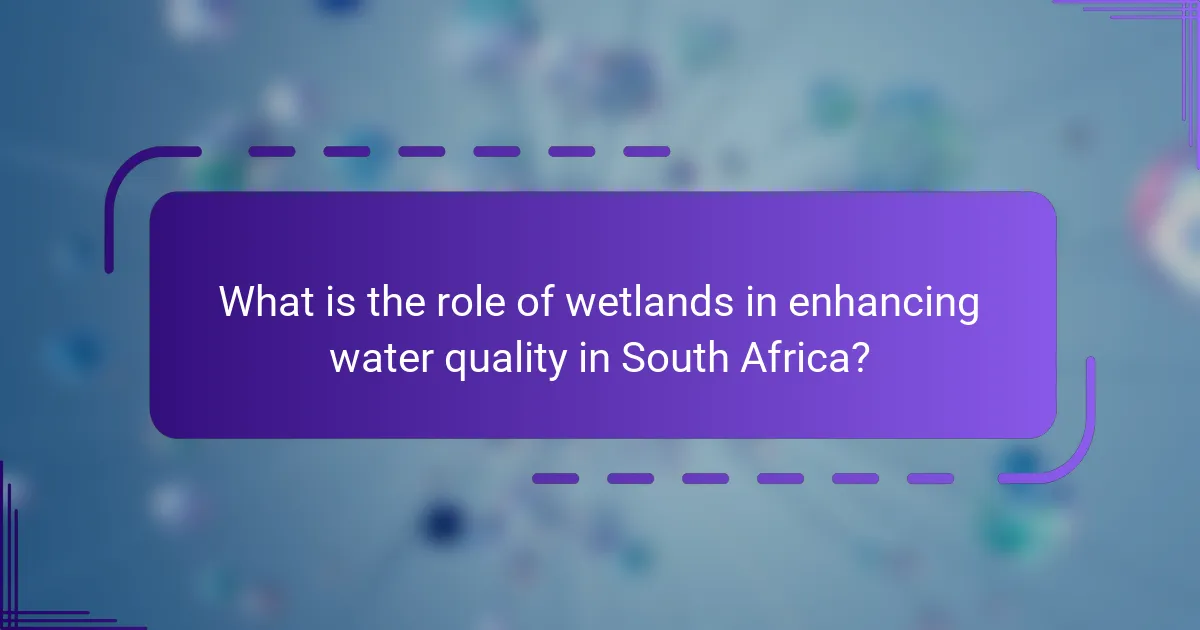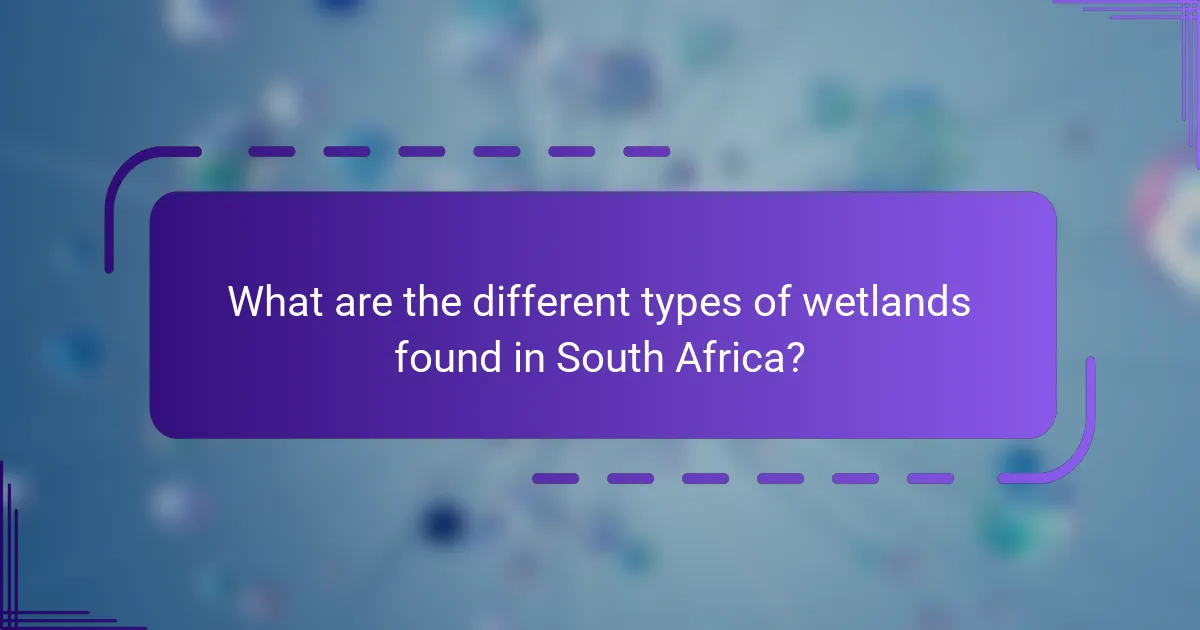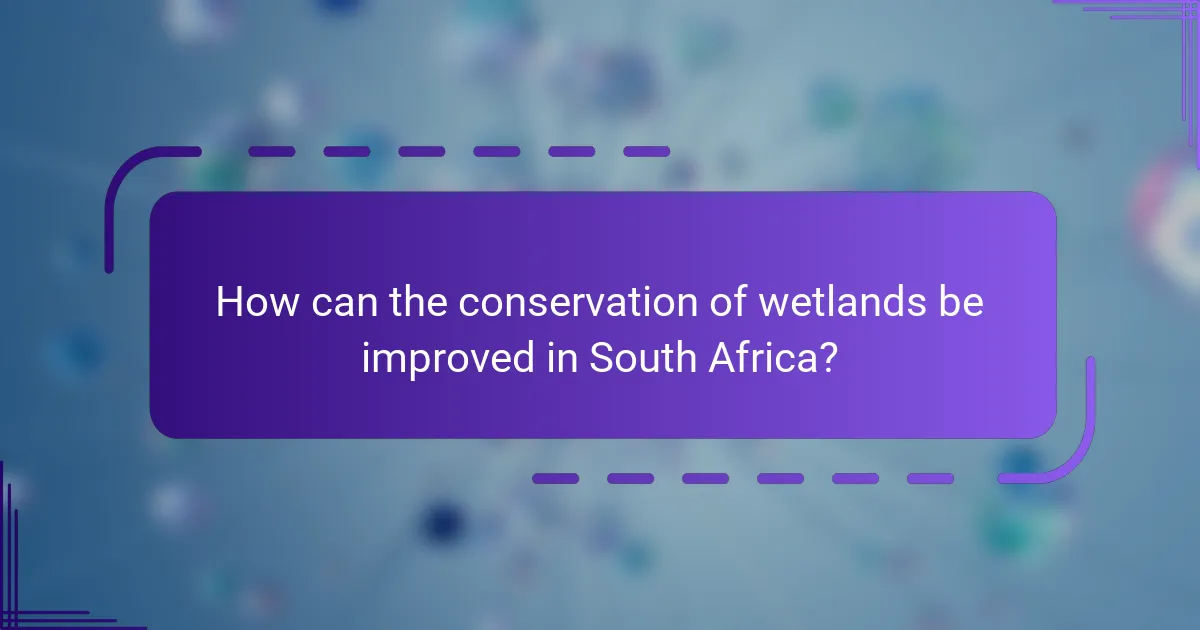Wetlands are vital ecosystems in South Africa that significantly enhance water quality. They function as natural filters, effectively removing pollutants and sediments from water, while also absorbing excess nutrients to prevent eutrophication. Various types of wetlands, including marshes, swamps, and floodplains, contribute to water clarity, habitat diversity, and flood control. The conservation of these wetlands is crucial and can be improved through effective policy implementation, community engagement, and sustainable land-use practices. Collaborative efforts among government, NGOs, and local communities are essential for successful wetland management and restoration.

What is the role of wetlands in enhancing water quality in South Africa?
Wetlands play a crucial role in enhancing water quality in South Africa. They act as natural filters, removing pollutants from water. Wetlands trap sediments, which helps reduce turbidity. They also absorb excess nutrients, such as nitrogen and phosphorus, preventing eutrophication. Furthermore, wetlands provide habitat for diverse species that contribute to ecosystem balance. According to the South African National Biodiversity Institute, wetlands improve water clarity and quality significantly. Their ability to retain water also mitigates flooding, promoting a stable hydrological cycle. Overall, wetlands are essential for maintaining healthy water systems in South Africa.
How do wetlands function to improve water quality?
Wetlands improve water quality by filtering pollutants and sediments. They act as natural sponges, absorbing excess nutrients like nitrogen and phosphorus. This absorption reduces the risk of algal blooms in adjacent water bodies. Wetlands also provide habitat for microorganisms that break down organic matter. These microorganisms contribute to the decomposition of harmful substances. Additionally, wetlands slow down water flow, allowing for sedimentation of particulates. This process further clarifies the water. Studies show that wetlands can remove up to 90% of pollutants from water. Their multifunctional role is vital for maintaining healthy ecosystems and clean water supplies.
What are the key processes through which wetlands filter pollutants?
Wetlands filter pollutants through several key processes. These processes include sedimentation, filtration, adsorption, and biological uptake. Sedimentation occurs when suspended particles settle out of the water column. This process reduces turbidity and removes contaminants. Filtration involves the physical trapping of particles by wetland vegetation and soil. Adsorption is the adherence of pollutants to soil and plant surfaces. Biological uptake refers to the absorption of nutrients and contaminants by wetland plants and microorganisms. Together, these processes enhance water quality by removing harmful substances from the water. Studies show that wetlands can remove up to 90% of certain pollutants, demonstrating their effectiveness in water purification.
How do wetlands contribute to nutrient cycling?
Wetlands contribute to nutrient cycling by acting as natural filters and buffers. They retain and transform nutrients, such as nitrogen and phosphorus, through microbial processes. This retention reduces nutrient runoff into adjacent water bodies. Wetlands also promote plant growth, which utilizes these nutrients for biomass production. The organic matter from decomposed plants further enriches the soil. Research shows that wetlands can remove up to 90% of excess nutrients from water. This process enhances water quality and supports biodiversity. Thus, wetlands play a crucial role in maintaining ecological balance and improving water quality.
What are the specific benefits of wetlands for water quality in South Africa?
Wetlands in South Africa provide significant benefits for water quality. They act as natural filters, removing pollutants from water. Wetlands trap sediments, reducing turbidity and improving clarity. They also absorb excess nutrients, such as nitrogen and phosphorus, preventing algal blooms. Furthermore, wetlands support biodiversity, which contributes to ecosystem resilience. The presence of vegetation in wetlands aids in stabilizing soil and preventing erosion. A study from the South African National Biodiversity Institute highlights these functions as critical for maintaining healthy water systems. Overall, wetlands play a vital role in enhancing the quality of water resources in South Africa.
How do wetlands support biodiversity and ecosystem health?
Wetlands support biodiversity and ecosystem health by providing critical habitats for a diverse range of species. They serve as breeding grounds for fish, amphibians, and birds. Wetlands also filter pollutants, improving water quality and supporting aquatic life. They act as buffers against flooding, protecting surrounding ecosystems. The complex plant life in wetlands stabilizes soil and prevents erosion. Wetlands are home to unique plant and animal species, contributing to overall biodiversity. According to the Ramsar Convention, wetlands are vital for maintaining ecological balance. Their preservation is essential for sustaining various life forms and ecosystem functions.
What economic advantages do healthy wetlands provide to local communities?
Healthy wetlands provide significant economic advantages to local communities. They support fisheries, which are vital for local food security and income. Wetlands also enhance tourism by attracting nature enthusiasts and bird watchers. This tourism generates revenue and creates jobs in hospitality and guiding services. Additionally, wetlands improve water quality, reducing treatment costs for communities. They act as natural buffers against floods, minimizing property damage and associated costs. The ecosystem services of wetlands contribute to agricultural productivity by maintaining soil health. Overall, healthy wetlands are essential for sustainable economic development in local areas.

What are the different types of wetlands found in South Africa?
South Africa has several types of wetlands. These include marshes, swamps, and floodplains. Marshes are characterized by herbaceous plants and are often found in low-lying areas. Swamps contain woody plants and typically have more standing water. Floodplains are areas adjacent to rivers that experience periodic flooding. Each type plays a crucial role in water quality enhancement. Wetlands filter pollutants and provide habitat for diverse species. They also help in flood control and maintain groundwater levels.
How do various wetland types differ in their water quality enhancement capabilities?
Different wetland types exhibit varying water quality enhancement capabilities. Freshwater wetlands, such as marshes, filter pollutants through vegetation and sediment. They effectively remove nutrients like nitrogen and phosphorus. Coastal wetlands, including mangroves, provide filtration and habitat for aquatic life. They also trap sediments and reduce erosion. Peatlands are known for their ability to sequester carbon and filter contaminants. They maintain water levels and improve water clarity. Each wetland type contributes uniquely to water quality through specific mechanisms and functions. Research indicates that these differences are crucial for ecosystem health and water management strategies.
What are the characteristics of freshwater wetlands?
Freshwater wetlands are ecosystems characterized by the presence of water, either at or near the surface, for a significant part of the year. They typically support a diverse range of plant and animal species. The soil in freshwater wetlands is often saturated, leading to unique hydric soil conditions. These wetlands can be categorized into marshes, swamps, and bogs based on their vegetation and hydrology. Freshwater wetlands play a crucial role in filtering pollutants, thus enhancing water quality. They also provide critical habitat for wildlife, including migratory birds and aquatic species. The biodiversity found in freshwater wetlands contributes to ecosystem resilience and stability. Additionally, they serve as natural buffers against flooding by absorbing excess water during heavy rains.
How do coastal wetlands contribute to water quality improvement?
Coastal wetlands improve water quality by filtering pollutants and sediments. They act as natural buffers, reducing nutrient runoff from land. This filtration process helps remove excess nitrogen and phosphorus, which can cause algal blooms. Coastal wetlands also trap sediments, preventing them from entering water bodies. This sediment retention improves clarity and quality of water. Furthermore, these ecosystems provide habitat for microorganisms that break down organic matter. Studies show that wetlands can reduce contaminants by up to 70%. Their ability to enhance water quality is crucial for maintaining healthy aquatic ecosystems.
What challenges do South African wetlands face in maintaining water quality?
South African wetlands face significant challenges in maintaining water quality. Pollution from agricultural runoff introduces pesticides and fertilizers, which degrade water quality. Urban development leads to increased sedimentation and contamination from wastewater. Invasive species disrupt the natural ecosystem, further compromising water quality. Climate change causes altered rainfall patterns, affecting water levels and quality. Overextraction of water resources diminishes wetland health, impacting filtration capabilities. These factors collectively threaten the ecological integrity of wetlands and their role in water purification.
How do human activities impact wetland ecosystems?
Human activities significantly impact wetland ecosystems through pollution, habitat destruction, and water diversion. Pollution from agricultural runoff introduces fertilizers and pesticides, harming aquatic life. Habitat destruction occurs due to urban development and land conversion for agriculture. This leads to loss of biodiversity and ecosystem services. Water diversion for irrigation reduces water levels in wetlands, affecting their function. According to the South African National Biodiversity Institute, wetlands are crucial for water purification and flood control. Their degradation threatens these essential services.
What climate change effects threaten wetland functions?
Climate change effects threaten wetland functions through increased flooding, droughts, and temperature changes. These changes disrupt the hydrology of wetlands, affecting water levels and flow patterns. Elevated temperatures can lead to increased evaporation rates, reducing water availability. Additionally, altered precipitation patterns can result in insufficient water supply during critical periods. Increased flooding can lead to erosion and habitat loss, degrading wetland ecosystems. These factors collectively impair the ability of wetlands to filter pollutants and support biodiversity. Research indicates that climate change could reduce wetland area by up to 30% by 2050, significantly impacting their ecological functions.

How can the conservation of wetlands be improved in South Africa?
Conservation of wetlands in South Africa can be improved through effective policy implementation and community engagement. Strengthening legal frameworks can enhance protection measures for wetlands. Increased funding for conservation projects can facilitate better management practices. Promoting awareness and education about wetlands can encourage community participation. Restoration of degraded wetlands can improve their ecological functions. Collaboration between government, NGOs, and local communities is vital for successful conservation efforts. Monitoring and research can provide data to inform conservation strategies. Implementing sustainable land-use practices can mitigate negative impacts on wetlands.
What best practices should be adopted for wetland management?
Best practices for wetland management include preserving existing wetlands, restoring degraded areas, and implementing sustainable land use practices. These actions help maintain biodiversity and ecosystem services. Monitoring water quality and hydrology is essential for effective management. Engaging local communities fosters stewardship and enhances conservation efforts. Establishing buffer zones around wetlands minimizes pollution and protects habitats. Educating stakeholders about the importance of wetlands promotes informed decision-making. Collaborative governance among government, NGOs, and communities ensures comprehensive management strategies. Research indicates that effective wetland management can significantly improve water quality and ecosystem health.
How can local communities be engaged in wetland conservation efforts?
Local communities can be engaged in wetland conservation efforts through education and participation. Educational programs can raise awareness about the importance of wetlands. Workshops can teach community members about wetland ecosystems. Involvement in local conservation projects can foster a sense of ownership. Community-led initiatives can include clean-up events and habitat restoration. Partnerships with local organizations can enhance resource availability. Incentives for sustainable practices can encourage long-term commitment. Studies show that community engagement leads to more effective conservation outcomes.
What role does policy play in protecting wetlands?
Policy plays a crucial role in protecting wetlands. It establishes regulations that govern land use and water management. Policies help mitigate threats from urban development and agriculture. They provide frameworks for conservation and restoration efforts. Effective policies promote sustainable practices that benefit wetland ecosystems. Legal protections often include designated wetland areas and funding for preservation. For example, the Ramsar Convention on Wetlands encourages international cooperation for wetland conservation. Such policies are essential for maintaining the ecological functions of wetlands, including water purification and flood control.
What practical steps can individuals take to support wetland health?
Individuals can support wetland health by engaging in conservation efforts. They can participate in local clean-up events to remove litter from wetland areas. Reducing the use of fertilizers and pesticides helps minimize chemical runoff into wetlands. Planting native vegetation around wetlands can enhance biodiversity and stabilize soil. Supporting policies that protect wetland areas ensures their preservation for future generations. Educating others about the importance of wetlands raises community awareness. Reporting pollution or illegal dumping in wetlands helps maintain their integrity. Lastly, practicing responsible water use contributes to overall wetland health.
Wetlands are vital ecosystems in South Africa that enhance water quality through natural filtration processes. They remove pollutants, absorb excess nutrients, and trap sediments, significantly improving water clarity and quality. This article outlines the functions and benefits of wetlands, including their role in nutrient cycling, biodiversity support, and economic advantages for local communities. It also addresses the challenges wetlands face, such as pollution and climate change, and discusses best practices for their conservation and management. The comprehensive overview emphasizes the importance of wetlands in maintaining healthy water systems and ecological balance in South Africa.